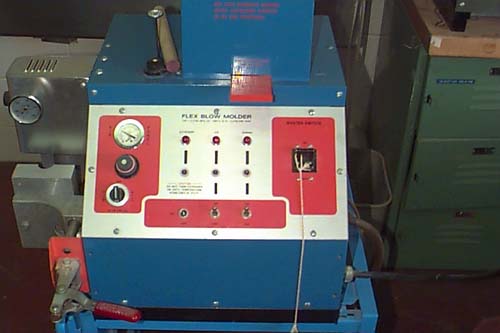home
Using the Blow Molder
|

|
The Blow-Molding machine is located in laboratory 109A of
the John Mitchell Center. Blow molding is a process
for forming hollow objects from thermoplastics.
Products such as bottles, garbage cans, and toys are
common.
This document describes the operation of the blow-molder
and safety practices.
|
Blow Molder Operation:
Caution: Follow these directions exactly to avoid damage to
this equipment.
1. Be sure all switches are in "OFF" position and that
key is removed from Extruder Switch.
2. Plug in molder, compressed air, and water supply tube.
3. Check to make sure water is running (it can be running very
slow).
4. Open mold far enough to make contact with micro switch.
This allows the extruder to run.
5. Turn barrel and die heater switches to "on".
6. Set barrel and die heat regulators to "50" which corresponds to
approximately 300 degrees Fahrenheit.
7. Adjust barrel and die tempatures to 300 degreees by turning
regulators down if tempature exceeds 300 degrees or by turning up if
pilot light goes out at less than 300 degrees.
8. Make sure plastic is in the hopper and that the feed slide gate
is open.
9. Turn air on and adjust to 5 to 15 PSI.
10. Only after barrel and die reaches
300 degrees Fahrenheit, turn on the extruder key.
11. If the extruder does not run, open mold further, to ensure
that the micro-switch has made contact.
12. When the parison is approximately 1/2" below the mold, close
mold and turn Blow Switch to "on" for approximately 10-15
seconds.
13. Open mold to remove product. (If right mold half is only
partially opened, extruder will not operate.)
14. Fully open mold to extrude new parison.
Blow Molder Shutdown/Safety:
1. Turn off and remove extruder key.
2. Turn off die, barrel, and master switch.
3. Turn off air.
4. Do Not turn of water until barrel
and die have cooled below 105 degrees (approximately one hour).
5. Ask for assistance if you are not sure how to operate the blow
molder.
6. Do not process materials in the blow molder if you do not know
how they will react.
7. Have a fire extinguisher handy when using the blow molder.
8. Wear safety glasses when using the blow molder.
9. Wear thermal gloves or use handling tools when removing hot
materials.
10. Do not leave the blow molder unattended when in use.
References:
Miller, W. R. (1978) Plastics Industrial Arts
Illinois: McKnight Publishing Company
Brent Strong A. (1996) Plastics Materials and
Processing New Jersey: Simon & Shuster
Prepared by Marcel Dube, 3/25/98
